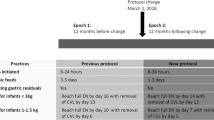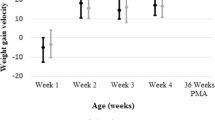Abstract
Objective:
To compare postnatal growth and nutritional deficits after the implementation of two different nutritional strategies in two consecutives periods of time.
Methods:
An early and aggressive nutritional regimen was used in a cohort of 117 very low birth weight (VLBW) infants. Amino acids were administered at the rate of 1.5 g/kg/day along with 5.6 mg/k/min of glucose flow on day 1 of life, and progressively increased to 4 g/kg/day and 13 mg/kg/min. Intravenous lipids were started at 0.5 g/kg/day at 24 h from birth, and increased to 3.5 g/kg/day; enteral feeding was begun at day 1 of life. Uni- and multivariate analyses were used to compare this group with the conventional group of 65 VLBW infants conservatively fed.
Results:
Univariate analysis showed that in the aggressive group there was a 66% reduction in the risk of post natal malnutrition at 40 weeks of postmenstrual age (OR 0.34; 95% CI 0.17–0.67). This difference persisted in the multivariate analysis. Energy and protein deficits were lower in the aggressive group (P<0.001).
Conclusions:
Early and aggressive introduction of total parenteral nutrition and enteral feeding resulted in better growth in weight, length and head circumference, and a reduction of nutritional deficits at 40 weeks of postmenstrual age.
This is a preview of subscription content, access via your institution
Access options
Subscribe to this journal
Receive 12 print issues and online access
$259.00 per year
only $21.58 per issue
Buy this article
- Purchase on Springer Link
- Instant access to full article PDF
Prices may be subject to local taxes which are calculated during checkout


Similar content being viewed by others
References
Lucas A, Morley R, Cole TJ, Gore SM, Lucas PJ, Crowle P et al. Early diet in preterm babies and development status at 18 months. Lancet 1990; 335: 1477–1481.
Barker DJ . Fetal growth and adult disease. Br J Obstet Gynaecol 1992; 99: 275–276.
American Academy of Pediatrics. Committee on Nutrition. Nutritional needs of low birth-weight infants. Pediatrics 1985; 76: 976.
Hay Jr WW, Lucas A, Heird WC, Ziegler E, Levin E, Grave GD et al. Workshop summary: nutrition of the extremely low birth weight infant. Pediatrics 1999; 104: 1360–1368.
Wilson DC, Cains P, Halliday HL, Reid M, McClure G, Dodge JA . Randomised controlled trial of an aggressive nutritional regimen in sick very low birth weight infants. Arch Dis Child Fetal Neonatal Ed 1997; 77: F4–F11.
Wilson DC, McClure G . Energy requirements in sick preterm babies. Acta Paediatr Suppl 1994; 405: 60–64.
Weinstein MR, Oh W . Oxygen consumption in infants with bronchopulmonary dysplasia. J Pediatr 1981; 99: 958.
Lejarraga H, Fustiñana C . Estándares de peso, longitud corporal y perímetro cefálico desde las 26 hasta las 92 semanas de edad postmenstrual. Arch Arg Pediat 1986; 84: 210–214.
San Pedro M, Grandi C, Larguía M, Solana C . Standard of birth weight for gestational age in 55 706 healthy newborns in a public maternity of Buenos Aries. Medicina (B Aires) 2001; 61: 15–22.
Walsh MC, Kleigman RM . Necrotizing enterocolitis: treatment based staging criteria. Pediatr Clin North Am 1986; 33: 179–201.
Papile LA, Burstein J, Koffler H . Incidence and evolution of subependymal and intraventricular hemorrhage: a study of infants with birth weights less than 1500 g. J Pediatr 1978; 92: 529–534.
De Rudd PT, Hughes EA, Platesezck MM, Hodes DT . References ranges for plasma creatinine during de first month of life. Arch Dis Child 1983; 58: 212.
Chevalier RL, Campbell F, Brenbridge AN . Prognostic factors in neonatal acute renal failure. Pediatrics 1984; 74 (2): 265–272.
Binder ND, Raschko PK, Benda GI, Reynolds JW . Insulin infusion with parenteral nutrition in extremely low birth weight infants with hyperglycemia. J Pediatr 1989; 114 (2): 273–280.
Murdock N, Crighton A, Nelson LM, Forsyth JS . Low birthweight infants and total parenteral nutrition immediately after birth II. Randomised study of biochemical tolerance of intravenous glucose, amino acids, and lipid. Arch Dis Child Fetal Neonatal Ed 1995; 73 (1): F8–F12.
Cowett RM . Pathophysiology, diagnosis, and management of glucose homeostasis in the neonate. Curr Probl Pediatr 1985; 15 (3): 1–47.
Ibrahim HM, Jeroudi MA, Baier RJ . Aggressive early total parental nutrition in low-birth-weight infants. J Perinatol 2004; 24 (8): 482–486.
Embleton NE, Pang N, Cooke RJ . Postnatal malnutrition and growth retardation: an inevitable consequence of recommendations in preterm infants? Pediatrics 2001; 107: 270–273.
Cooke RJ . Nutrient requirements in preterm infants. Pediatr Res 2003; 53 (1): 2.
Kashyap S, Schulze KF, Forsyth M, Zucker C . Growth, nutrient retention, and metabolic response in low birth weight infants fed varying intakes of protein and energy. J Pediatr 1988; 113: 713–721.
Hammerman C, Aramburo MJ . Decreased lipid intake reduces morbidity in sick premature neonates. J Pediatr 1988; 113: 1083–1088.
Yunis KA, Oh W . Effects of intravenous glucose loading on oxygen consumption, carbon dioxide production, and resting energy expenditure in infants with bronchopulmonary dysplasia. J Pediatr 1989; 115 (1): 127–132.
Tyson JE, Kennedy KA . Minimal enteral nutrition for promoting feeding tolerance and preventing morbidity in parenterally fed infants. Cochrane Database Syst Rev 2000; (2): CD000504. Update in: Cohrane Database Syst Rev 2005; (3): CD000504.
McClure RJ, Newell SJ . Randomised controlled study of clinical outcome following trophicfeeding. Arch Dis Child Fetal Neonatal Ed 2000; 82: F29.
Ehrenkranz RA, Younes N, Lemons JA, Fanaroff AA, Donovan EF, Wright LL et al. Longitudinal growth of hospitalized very low birth weight infants. Pediatrics 1999; 104: 280–289.
Ziegler EE, Thureen PJ, Carlson S . Aggressive nutrition of the very low birth weight infant. Clin Perinatol 2002; 29: 225–244.
Thureen PJ, Melara D, Fennessey PV . Effect of low versus high intravenous amino acid intake on very low birth weight infants in the early neonatal period. Pediatr Res 2003; 53: 24–32.
Van Goudoever JB, Colen T, Wattimena JL . Immediate commencement of amino acid supplementation in preterm infants: effect on serum amino acid concentrations and protein kinetics on the first day of life. J Pediatr 1995; 127 (3): 458–465.
Rivera A, Bell E, Bier D . Effect of intravenous amino acids on protein metabolism of preterm infants during the firt three days of life. Pediatr Res 1993; 33: 106–111.
Ziegler EE . Protein in premature feeding. Nutrition 1994; 10: 69–71.
Thureen P, Heird WC . Protein and energy requirements of the preterm low birthweight (LBW) infant. Pediatr Res 2005; 57: 95R–98R.
Dusick A, Poindexter B, Ehrenkranz R . Growth failure in the preterm infant: can we catch up? Semin Perinatol 2003; 27 (4): 302–310.
Acknowledgements
We thank Dr Ruben Alvaro, Professor of Pediatrics, University of Manitoba at Winnipeg, for help with manuscript and useful comments.
Author information
Authors and Affiliations
Corresponding author
Rights and permissions
About this article
Cite this article
Dinerstein, A., Nieto, R., Solana, C. et al. Early and aggressive nutritional strategy (parenteral and enteral) decreases postnatal growth failure in very low birth weight infants. J Perinatol 26, 436–442 (2006). https://doi.org/10.1038/sj.jp.7211539
Received:
Revised:
Accepted:
Published:
Issue Date:
DOI: https://doi.org/10.1038/sj.jp.7211539
Keywords
This article is cited by
-
Early high amino-acid intake is associated with hypophosphatemia in preterm infants
Journal of Perinatology (2022)
-
The glucose infusion rate of parenteral nutrition in the first week of life in preterm infants: an observational study
Italian Journal of Pediatrics (2021)
-
Human induced pluripotent stem cell derived hepatocytes provide insights on parenteral nutrition associated cholestasis in the immature liver
Scientific Reports (2021)
-
Antenatal and neonatal factors contributing to extra uterine growth failure (EUGR) among preterm infants in Boston Birth Cohort (BBC)
Journal of Perinatology (2021)
-
Factors associated with early phosphate levels in preterm infants
European Journal of Pediatrics (2020)



